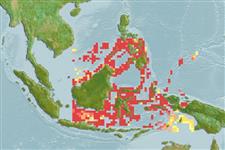Common names from other countries
Classification / Names / Names
आम नाम | उपशब्द | Catalog of Fishes (gen., sp.) | ITIS | CoL | WoRMS
Environment: milieu / climate zone / depth range / distribution range
पारिस्थितिकी
. Tropical; 23°C - 30°C (Ref. 102835); 13°N - 9°S, 109°E - 139°E (Ref. 106696)
Western Central Pacific: Restricted in the tropical western Pacific. From Sabah, Malaysia to Palau, north to Philippines and south to Indonesia.
Length at first maturity / आकार / वज़न / Age
Maturity: Lm ? range ? - ? cm Max length : 41.1 cm SHL पुल्लिंग / अलिंग; (Ref. 117184); common length : 20.0 cm SHL पुल्लिंग / अलिंग; (Ref. 348)
Its shell is thinner and smoother than that of H. hippopus, usually devoid of pigmentation, and more semi-circular in profile. The mantle is similar to that of H. hippopus (Rosewater, 1982), except that prominent papillae line the margins of the incurrent siphon.
Collected for food and shell (Ref. 348).
Life cycle and mating behavior
परिपक्व अवधि | पुनरुत्पत्ति | मछलीऔ का अंडे देना | अंडे | Fecundity | लार्वा
Broadcast spawners. Life cycle: Embryos develop into free-swimming trocophore larvae, succeeded by the bivalve veliger, resembling a miniature clam (Ref. 833).
Poutiers, J.M. 1998. (Ref. 348)
IUCN Red List Status (Ref. 130435: Version 2024-1)
CITES status (Ref. 108899)
Not Evaluated
Threat to humans
Harmless
Human uses
मात्स्यिकी: व्यापारिक
FAO - जलीयकृषि: production; | FishSource | Sea Around Us
साधन
इंटरनेट स्रोत
Estimates based on models
लौटाव
निम्न, न्यूनतम जनसंख्या दुगनी होने का समय 4.5 - 14 वर्ष। (K=0.13).
Vulnerability
Moderate to high vulnerability (51 of 100).
Price category
Unknown.
